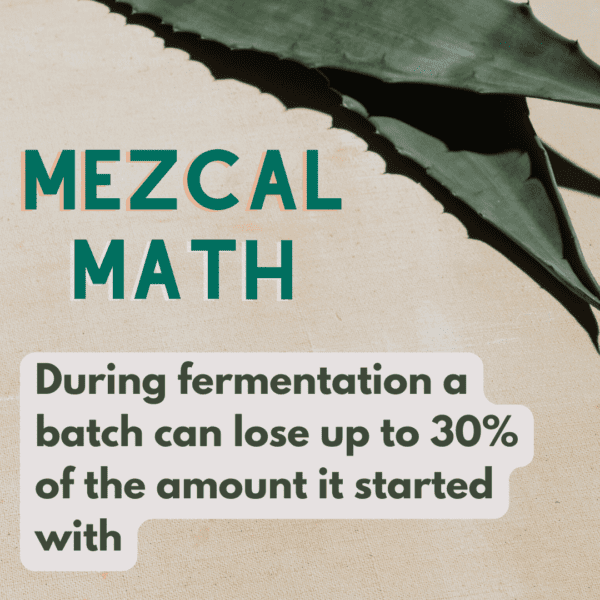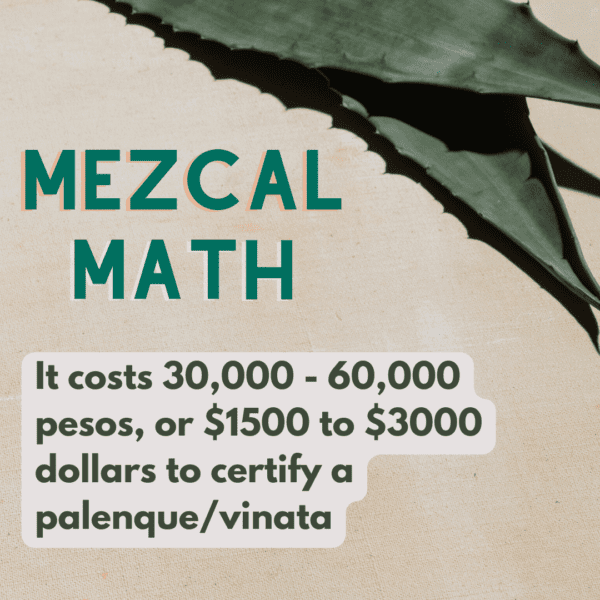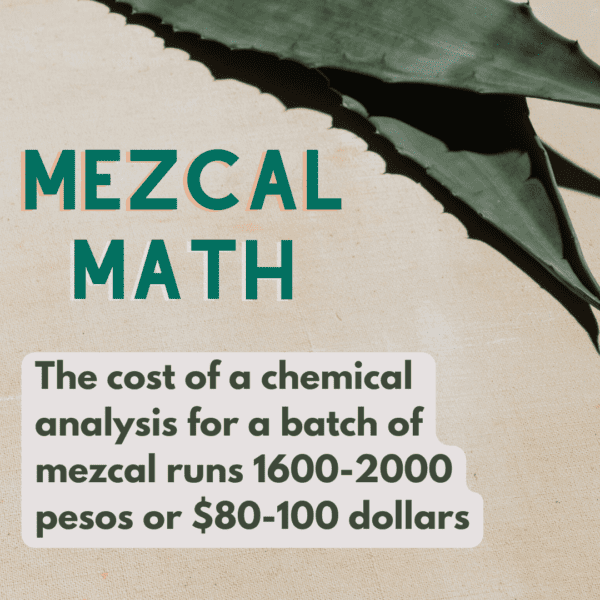Many people wonder why mezcal is expensive. The real question is why some botles of mezcal are not more expensive. The truly inquisitive ask us to quantify what goes into the making of mezcal. For example, how much agave does it take to make one bottle of mezcal? How many liters of water does it take to make one bottle of mezcal? And while these seem like pretty straightforward questions, the answers are not so easy because they depend on a lot of variables, hence why we use words like generally, on average, or usually.
The information below is intended to clarify and provide some basic numbers on the true cost of making of mezcal.
- Exchange rate used – 20 pesos per dollar
- One kilo = 2.2 pounds
- 1 ton = 2000 pound

On average, it takes 10 kg or 22 pounds of espadin agave to make one liter of mezcal.
- Espadin piñas on average weigh about 70 kilos or 154 pounds so one piña can make 7 liters
- A kilo of mature Espadin costs around 5 pesos (March 2024.)
- An average Espadin piña therefore costs 350 pesos or $17.50 dollars
- It costs about 50 pesos or $2.50 USD in agave to make a liter of Espadin mezcal
- An 320 liter batch (output from a four ton oven) of Espadin costs 16,000 pesos or $800 dollars in agave alone and uses approximately 45.7 piñas

On average it takes 10 kg or 22 pounds of Tobala, if it is a fully mature plant, to make one liter of mezcal
- But bear in mind, a tobala piña on average weighs about 15 kilos (33 pounds) so it takes almost a whole piña to make one liter of mezcal
- A kilo of tobala costs around 13 pesos (December 2022)
- A Tobala piña therefore costs around 195 pesos or $9.75 dollars
- It costs about 130 pesos or $6.50 in agave to make a liter of Tobala mezcal
- A 100 liter batch of Tobala costs 13,000 pesos or $650 dollars in agave alone and uses approximately 100 piñas

When mezcal is made with agave at their peak brix, or sugar content, the results create a better yield and flavor
- An instrument called a refractometer is used to measure the brix
- The brix number signifies the percentage of sugar in the “fruit”
- Optimum brix for espadin is above 30, or 30% of the content in the piña is sugar
- Optimum brix for tobala is above 25, or 25% of the content in the piña is sugar
- Optimum brix for tepeztate is 22, or 22% of the content in the piña is sugar

The average size of an horno (oven) used to roast agave is four tons or 8000 pounds
- Generally, 240 kg of wood, or 528 pounds, is needed for a four ton oven
- On average, wood costs 20 pesos or $1 USD per pound. It therefore would cost about 10,560 pesos or $528 USD in wood for each roast in a four ton oven
- A four ton oven filled with espadin usually yields about 320 liters of mezcal
- It therefore costs about $1.65 USD in wood per liter of mezcal made

On average it takes 10 liters of water to make one liter of mezcal
- This means it takes 3,200 liters of water to make 320 liters of mezcal, the average amount made from a four ton oven

On average one liter of mezcal creates 10 liters of viñaza, or waste water
- This means 3,200 liters of viñaza are created from 320 liters of mezcal, anaverage batch size from a four ton oven
- For large production runs that make 25,000 liters of mezcal a month, 250,000 liters of viñaza are created
- Viñaza waste must be treated before it can be released because it is a serious pollutant
- Some solutions include building large containment tanks or using chemical additives to neutralize the most toxic and acidic compounds in viñaza

On average one liter of mezcal espadin distilled in copper creates 5 – 6kg or 11 – 13.2 pounds of bagaso, or spent agave fibers
- A 320 liter batch therefore produces 3,520 to 4,224 pounds of bagaso
- The majority of bagaso is reused as compost for the fields or as fuel or cover in the agave roasting process
- There are some cases where the bagaso is used in the making of adobe bricks

On average, during fermentation a batch can lose up to 30% of what it started with
- This means that if you start with a batch of 100 liters, 70 liters will be distilled
- Factors that can impact how much is loss include temperature and weather and the material of fermentation tanks.

During distillation, a batch can lose up to 30% of production depending on the type of still (clay pot distillation loses more than copper)
- This means if you have 70 liters to distill, your final batch size will be 49 liters
- Factors that can determine how much is lost include temperature and weather, how well the seals work on the still and consistency of the temperature of the fire.

100 liters of mezcal is equal to 133 750ml bottles
- There are typically (6) 750ml bottles, or 4.5 liters, in 1 case of mezcal
- 100 liters of mezcal equals about 22 cases of mezcal
- One pallet of mezcal is about 468 liters or 104 cases

It costs 30,000 – 60,000 pesos, or $1500 to $3000 dollars to certify a palenque/vinata
- This does not include the cost of having to hire an accountant or lawyer or the costs in registering a business with the Hacienda (a sort of Mexican IRS)
- This cost will figure into the final cost of each liter of mezcal a producer sells, amortized over time.

The cost of a chemical analysis for a batch of mezcal runs 1600 – 2000 pesos or $80 – 100
dollars
- While this may not seem like a lot of money, these costs can add up if you are analyzing several batches of mezcal each month or year.
- This means for any 320 liter batch, 5-6 pesos or $.25-.30 cents is added into the cost of a liter of mezcal
- For a 100 liter batch the cost would be 16-20 pesos or $.80-$1.00, added to the cost of each liter.


The average markup on a bottle of mezcal per bar sale based on pours is 500%
- While this markup seems incredibly high it is very important to remember that the costs of running a bar (rent, labor, materials, et al) are factored into the pricing ofeach pour

2023 Mezcal exports to the US totaled about 803,000 9L cases or 7,227,000 million liters, enough to fill 3 Olympic size pools with mezcal
- This equals approximately 9,612,000 million 750ml bottles of mezcal.
- This means approximately 160.6 million pounds of agave, 72.3 million liters of water and 12.1 million pounds of wood were used to make the mezcal.
- This also means that about 72.3 million liters of vinaza and about 86.7 million pounds of bagaso were created from the production of the mezcal.

Over the past year 2023-2024, Dollar to Peso exchange rates have fluctuated from 16.5 to 18.5 pesos to the dollar.
- For the average tourist to Mexico, that doesn’t really mean much. At 16.5 pesos, $20 equals 330 pesos, at 18.5 $20 equals 370 pesos, the difference pretty much the cost of a beer.
- For people involved in trade, and specifically mezcal, it impacts how much money ultimately ends up in one’s pocket.
- If an importer is buying 10 pallets of espadin (1040 (6L) cases of 750ml bottles) at an approximate cost of 112 pesos per bottle for liquid only, the total cost would be 698,880 mxn.
- If an importer is buying in pesos, at an exchange rate of 16.5 pesos to the dollar that equals $42,356. At an exchange rate of 18.5 pesos to the dollar that equals $37,777, a difference/loss of $4,579 to the importer.
- If the importer is buying in dollars, that means a difference/loss of $4,579 to the producer.
- **This is only for the cost of the mezcal itself and does not include the costs of the bottles, labeling, packaging or any bank transaction fees.
